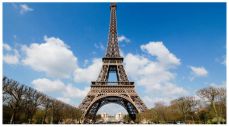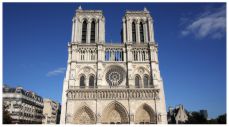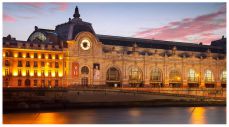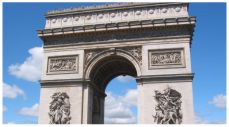France is Europe's most diverse, tasty, and, in many ways, most exciting country to explore. It's a place of gentle beauty, where the play of light transforms the routine into the exceptional. Here, travelers are treated to a blend of man-made and natural beauty like nowhere else in Europe. With luxuriant forests, forever coastlines, truly grand canyons, and Europe's highest mountain ranges, France has a cover-girl beauty from top to bottom. You'll also discover a dizzying array of artistic and architectural wonders — soaring cathedrals, chandeliered châteaux, and museums filled with the cultural icons of the Western world
At a Glance
PLAN YOUR TOUR
3 Days:Paris, maybe Versailles 6 Days, add: Normandy 8 Days, add: Loire 11 Days, add:Dordogne, Carcassonne 16 Days, add:Provence, Riviera 19 Days, add:Burgundy, Chamonix 22 Days, add:Alsace, northern France 26 Days, add:Basque Country
With More Time:
If you have only a week and it's your first trip to France, do Paris, Normandy, and the Loire. For a 10- to 14-day trip that highlights Paris, Provence, and the Riviera, fly into Paris and out of Nice. After touring Paris, take the TGV train to Avignon, rent a car there, and drop it in Nice (or use trains, buses, and minivan tours to get around). This trip also works well in reverse. Travelers with a little more time could add Burgundy and/or the Alps, which are about halfway between Paris and Provence and easy to explore by car or train.
Things To Do:
*Paris World capital of art, fashion, food, literature, and ideas, offering historic monuments, grand boulevards, corner cafés, chic boutiques, cutting-edge architecture, and world-class art galleries, including the Louvre and Orsay.
* Provence Home to Arles (Van Gogh sights, evocative Roman arena), Avignon (famous bridge and brooding Palace of the Popes), the ancient Roman aqueduct of Pont du Gard, Orange (Roman theater), the beautiful Côtes du Rhone wine road, and rock-top villages such as Les Baux, Roussillon, and Vaison-la-Romaine.
* The French Riviera A string of coastal resorts, including Nice (big city with seafront promenade and art museums), romantic Villefranche-sur-Mer, glitzy Monaco (casino), easygoing Antibes (silky-sandy beaches), and little hilltop Eze-le-Village, with magnificent Mediterranean views.
* Burgundy Aged blend of vineyards and spirituality, with the compact town of Beaune (world-famous vineyards), Fontenay (France's best-preserved medieval abbey), Vézelay (magnificent Romanesque church), the one-of-a-kind medieval castle under construction at Guédelon, Cluny's grand medieval abbey, and the modern-day religious community of Taizé.
* Normandy Pastoral mix of sweeping coastlines, half-timbered towns, and intriguing cities, including bustling Rouen (Gothic architecture, Joan of Arc sites), the little romantic port town of Honfleur, historic Bayeux (remarkable tapestry on the Battle of Hastings), stirring D-Day sites and museums, and the almost surreal island abbey of Mont St-Michel.
* The Loire Picturesque towns (such as Amboise and Chinon) and hundreds of castles and palaces, including Chenonceaux (arcing across its river), the huge Château de Chambord, Villandry (wonderful gardens), lavishly furnished Cheverny, and many more.
* Dordogne Prehistoric caves, rock-sculpted villages, lazy canoe rides past medieval castles, market towns such as pedestrian-friendly Sarlat-la-Canéda, and nearby, for wine lovers, St-Emilion.
* Near Paris Europe's best palace at Versailles, the awesome cathedral of Chartres, Monet's flowery gardens at Giverny, and a mouse-run amusement park.
* Alsace Franco-Germanic region dotted with wine-road villages, starring half-timbered Colmar and its world-class art, and high-powered Strasbourg and its sensational cathedral.
* Reims and Verdun Champagne-soaked Reims with a historic cathedral and cellars serving the sparkling brew, and nearby Verdun, site of horrific WWI battles, with a compelling, unforgettable memorial.
* Brittany Windswept and rugged, with a forgotten interior, gorgeous coast, Celtic ties, and two notable towns: Dinan (Brittany's best medieval center) and the beach resort of St-Malo.
* Languedoc-Roussillon Sunny region with a Spanish flair, featuring Albi (fortress-like cathedral and a beautiful Toulouse-Lautrec museum), medieval Carcassonne (walled town with towers, turrets, and cobblestones), remote Cathar castles, and the lovely Mediterranean village of Collioure.
* The French Alps Spectacular scenery featuring the drop-dead gorgeous town of Annecy, Mont Blanc (Europe's highest peak), and the world-famous ski resort of Chamonix, with hikes galore and lifts to stunning alpine views.
* Basque Country Isolated yet beautiful region anchored by the seaside resort town of St-Jean-de-Luz and the riverside town of Bayonne, with lovely villages dotting the countryside and easy access to cities and sights across the border in Spain.
* Lyon Metropolitan city, located between Burgundy and Provence, with an Italianesque old town, two Roman theaters, a terrific Gallo-Roman museum, the stirring French Resistance Center, and delicious cuisine at affordable prices.
When to Go
Late spring and fall are best, with generally good weather and lighter crowds, though summer brings festivals, animated villages, reliable weather, and long opening hours at sights. Europeans vacation in July and August, jamming the Riviera, the coast of Brittany, the Dordogne, and the Alps (worst from mid-July to mid-August), but leaving the rest of the country just lively enough for tourists. And though many French businesses close in August, the traveler hardly notices. May weekends can be busy — many French holidays fall in this month — but June is generally quiet (outside of Paris). Winter travel is fine for Paris, Nice, and Lyon, but you'll find smaller cities and villages buttoned up tight. Winter weather is gray, noticeably milder in the south (unless the wind is blowing), and colder and wetter in the north. Snow is generally not an issue except in the mountains. Sights and tourist information offices keep shorter hours, and some tourist activities (such as English-language castle tours) vanish altogether. On the other hand, winter travel allows you to see cities through the lens of a local, as hotels, restaurants, and sights are much calmer.
What's Blooming When
Thanks to France's relatively mild climate, fields of flowers greet the traveler much of the year: Mid-April–May: Crops of brilliant yellow colza bloom, mostly in the north (best in Burgundy). Wild red poppies (coquelicots) begin sprouting in the south. June: Red poppies pop up throughout the country. Late in June, lavender blooms begin covering the hills of Provence. July: Lavender is in full swing in Provence, and sunflowers are awakening. Cities, towns, and villages everywhere overflow with carefully tended flowers. August–September: Sunflowers flourish north and south. October: In the latter half of the month, the countryside glistens with fall colors, as most trees are deciduous. Vineyards go for the gold.






